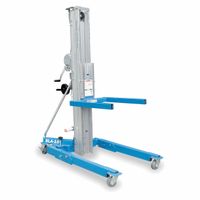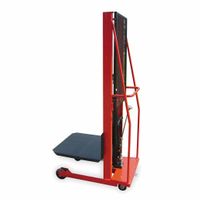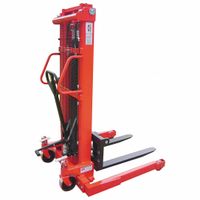Call +(254) 703 030 000 / 751 483 999 / 721 704 777
- Home
- Material Handling
- Transporting
- Lift Trucks
.....Read More
Frequently Asked Questions
What are the different types of lift trucks?
Lift trucks, commonly known as forklifts, come in various types designed for specific tasks and environments. Here are the main types:
1. **Counterbalance Forklifts**: The most common type, featuring forks at the front and a weight at the back to balance loads. Suitable for indoor and outdoor use.
2. **Reach Trucks**: Designed for warehouse operations, these trucks have extended reach capabilities, allowing them to access high shelves in narrow aisles.
3. **Pallet Jacks**: Also known as pallet trucks, these are used for moving pallets over short distances. They come in manual and electric versions.
4. **Order Pickers**: Used in warehouses for picking individual items from shelves, these trucks lift the operator to the height of the item.
5. **Rough Terrain Forklifts**: Built for outdoor use on uneven surfaces, these forklifts have large, rugged tires and are often used in construction sites.
6. **Telehandlers**: Equipped with a telescopic boom, these versatile machines can lift loads to great heights and are used in agriculture and construction.
7. **Side Loaders**: Ideal for handling long or bulky items like timber or pipes, these trucks load from the side and are used in narrow aisles.
8. **Industrial Forklifts**: Heavy-duty trucks designed for lifting extremely heavy loads, often used in manufacturing and large-scale warehousing.
9. **Articulated Forklifts**: These have a flexible design that allows them to operate in very narrow aisles, combining the benefits of reach and counterbalance forklifts.
10. **Turret Trucks**: Used in very narrow aisle applications, these trucks can rotate the forks 180 degrees, allowing for efficient picking and placing of items.
Each type of lift truck is designed to optimize efficiency and safety in specific environments and tasks.
How do you operate a lift truck safely?
To operate a lift truck safely, follow these guidelines:
1. **Pre-Operation Inspection**: Check the lift truck for any damage or issues. Inspect tires, brakes, steering, controls, warning devices, and the mast. Ensure the forks are in good condition.
2. **Training and Certification**: Only trained and certified operators should use lift trucks. Understand the specific model's controls and capabilities.
3. **Load Handling**: Know the load capacity and never exceed it. Ensure the load is stable and secure before lifting. Use proper attachments if necessary.
4. **Mounting and Dismounting**: Use the three-point contact method (two hands and one foot or two feet and one hand) when getting on or off the lift truck.
5. **Starting the Lift Truck**: Ensure the parking brake is engaged and the controls are in neutral before starting. Adjust the seat and mirrors for optimal visibility.
6. **Safe Driving Practices**: Keep the forks low while moving. Drive at safe speeds, especially when turning or on inclines. Maintain a safe distance from other vehicles and pedestrians.
7. **Visibility and Awareness**: Ensure clear visibility. Use mirrors and look in the direction of travel. Be aware of blind spots and obstacles.
8. **Operating on Ramps and Inclines**: Drive forward going up and in reverse going down. Keep the load uphill.
9. **Parking**: Park on level ground, lower the forks, set the parking brake, and turn off the engine. Remove the key when leaving the lift truck unattended.
10. **Communication**: Use horns and signals to alert others of your presence. Follow site-specific communication protocols.
11. **Emergency Procedures**: Know the emergency procedures and how to shut down the lift truck quickly if needed.
By adhering to these practices, operators can ensure safe and efficient lift truck operation.
What is the maximum weight a lift truck can handle?
The maximum weight a lift truck, or forklift, can handle depends on several factors, including the type, model, and design of the forklift. Generally, forklifts are categorized by their load capacity, which can range from a few thousand pounds to over 100,000 pounds for specialized models.
1. **Standard Warehouse Forklifts**: These typically have a load capacity ranging from 3,000 to 5,000 pounds. They are commonly used in warehouses and retail settings for handling pallets and other standard loads.
2. **Heavy-Duty Forklifts**: These are designed for more demanding applications and can handle loads between 10,000 to 30,000 pounds. They are often used in industrial settings, such as construction sites and manufacturing plants.
3. **Specialized Forklifts**: Some forklifts are designed for specific tasks and can handle extremely heavy loads. For example, container handlers and reach stackers used in ports can lift up to 100,000 pounds or more.
4. **Electric vs. Internal Combustion**: Electric forklifts generally have lower load capacities compared to internal combustion models, which are more powerful and can handle heavier loads.
5. **Load Center**: The load capacity of a forklift is also affected by the load center, which is the distance from the front of the forks to the center of gravity of the load. A standard load center is typically 24 inches, and exceeding this can reduce the forklift's effective capacity.
6. **Attachments**: The use of attachments, such as clamps or extensions, can also impact the maximum weight a forklift can handle, often reducing its capacity due to the added weight and altered center of gravity.
Always refer to the manufacturer's specifications and load capacity chart for accurate information on a specific forklift model.
How often should lift trucks be maintained?
Lift trucks should be maintained regularly to ensure safety, efficiency, and longevity. The frequency of maintenance depends on several factors, including the manufacturer's recommendations, the intensity of use, and the operating environment. Generally, lift trucks should undergo:
1. **Daily Inspections**: Operators should perform daily checks before each shift. This includes examining brakes, steering, controls, warning devices, mast, tires, and fluid levels. Any issues should be reported immediately.
2. **Planned Maintenance**: Typically scheduled every 250 to 500 hours of operation, depending on the manufacturer's guidelines. This involves more detailed inspections and servicing, such as changing oil and filters, checking hydraulic systems, and inspecting electrical components.
3. **Quarterly or Semi-Annual Maintenance**: For lift trucks used in moderate conditions, a more comprehensive inspection and servicing every three to six months is advisable. This includes checking the engine, transmission, and cooling systems, as well as lubricating moving parts.
4. **Annual Maintenance**: A thorough inspection and overhaul should be conducted annually. This involves a complete check of all systems, including safety features, structural components, and performance testing.
5. **Condition-Based Maintenance**: In some cases, maintenance is scheduled based on the condition of the equipment rather than a set timeline. This approach uses data from sensors and diagnostics to determine when maintenance is needed.
6. **Environmental Considerations**: Lift trucks operating in harsh environments, such as extreme temperatures, dusty areas, or corrosive conditions, may require more frequent maintenance.
Adhering to a regular maintenance schedule helps prevent breakdowns, reduces repair costs, and ensures compliance with safety regulations. Always consult the lift truck's manual and follow the manufacturer's specific maintenance recommendations.
What are the safety features of a lift truck?
Lift trucks, commonly known as forklifts, are equipped with various safety features to ensure the protection of operators and bystanders. Key safety features include:
1. **Overhead Guard**: Protects the operator from falling objects.
2. **Load Backrest**: Prevents the load from falling backward onto the operator.
3. **Seat Belt**: Keeps the operator securely in the seat, reducing the risk of injury during sudden stops or accidents.
4. **Operator Presence System**: Disables the lift and tilt functions when the operator is not seated, preventing unintended movements.
5. **Tilt Lock**: Prevents the mast from tilting when the lift truck is not in use.
6. **Speed Control**: Limits the maximum speed of the forklift to prevent accidents.
7. **Horn and Audible Alarms**: Alerts pedestrians and other operators of the forklift's presence.
8. **Mirrors**: Enhances visibility around the forklift, reducing blind spots.
9. **Lighting**: Includes headlights, tail lights, and warning lights for better visibility in low-light conditions.
10. **Backup Alarm**: Sounds when the forklift is in reverse, warning nearby individuals.
11. **Load Weight Indicator**: Displays the weight of the load to prevent overloading.
12. **Stability Control System**: Helps maintain balance and prevent tipping.
13. **Anti-Slip Steps and Handholds**: Provide secure footing and grip for operators entering and exiting the forklift.
14. **Emergency Stop Button**: Allows the operator to quickly shut down the forklift in case of an emergency.
15. **Fire Extinguisher**: Mounted on the forklift for quick access in case of a fire.
These features collectively enhance the safety of lift truck operations, minimizing the risk of accidents and injuries. Regular maintenance and operator training are also crucial for ensuring these safety features function effectively.
How do you choose the right lift truck for your needs?
To choose the right lift truck, consider the following factors:
1. **Load Capacity**: Determine the maximum weight the lift truck needs to handle. Choose a truck with a capacity slightly above your maximum requirement to ensure safety and efficiency.
2. **Lift Height**: Assess the height to which loads need to be lifted. Ensure the lift truck can reach the highest point required in your operations.
3. **Environment**: Consider whether the truck will be used indoors or outdoors. For indoor use, electric forklifts are ideal due to zero emissions and quieter operation. For outdoor use, diesel or LPG forklifts are more suitable due to their power and durability.
4. **Surface Conditions**: Evaluate the terrain where the lift truck will operate. Rough terrain forklifts are necessary for uneven surfaces, while standard forklifts are suitable for smooth, paved areas.
5. **Maneuverability**: Consider the space available for the lift truck to operate. Narrow aisle forklifts or reach trucks are ideal for tight spaces, while standard forklifts are suitable for more open areas.
6. **Fuel Type**: Decide between electric, diesel, or LPG based on cost, environmental impact, and operational needs. Electric forklifts are cost-effective and eco-friendly, while diesel and LPG offer more power for heavy-duty tasks.
7. **Attachments**: Identify any specific attachments needed for your operations, such as clamps, rotators, or side shifters, to enhance the lift truck's versatility.
8. **Operator Comfort and Safety**: Ensure the lift truck has ergonomic features and safety systems to reduce operator fatigue and enhance safety.
9. **Budget**: Balance your needs with your budget, considering both initial purchase costs and long-term operational expenses.
10. **Maintenance and Support**: Choose a lift truck brand with reliable service and support to minimize downtime and ensure efficient operations.
What are the common causes of lift truck accidents?
Common causes of lift truck accidents include:
1. **Operator Error**: Inadequate training or lack of experience can lead to improper handling, misjudgment of load capacity, and unsafe driving practices.
2. **Speeding**: Operating a lift truck at excessive speeds increases the risk of tipping over, losing control, or colliding with obstacles or pedestrians.
3. **Poor Maintenance**: Failure to regularly inspect and maintain lift trucks can result in mechanical failures, such as brake malfunctions or steering issues.
4. **Overloading**: Exceeding the lift truck's load capacity can cause instability, leading to tipping or dropping the load.
5. **Improper Loading**: Incorrectly securing or balancing loads can result in shifting or falling loads, posing a danger to operators and nearby workers.
6. **Inadequate Workplace Design**: Narrow aisles, cluttered workspaces, and poor lighting can contribute to accidents by limiting visibility and maneuverability.
7. **Pedestrian Traffic**: Lack of clear separation between lift truck operations and pedestrian pathways increases the risk of collisions.
8. **Environmental Factors**: Wet, icy, or uneven surfaces can affect traction and stability, leading to accidents.
9. **Fatigue**: Tired operators may have slower reaction times and impaired judgment, increasing the likelihood of errors.
10. **Distractions**: Use of mobile phones or engaging in conversations while operating a lift truck can divert attention from safe operation.
11. **Improper Use of Attachments**: Using incorrect or poorly maintained attachments can affect the lift truck's balance and handling.
12. **Lack of Safety Protocols**: Absence of or non-compliance with safety guidelines and protocols can lead to unsafe practices and increased accident risk.


